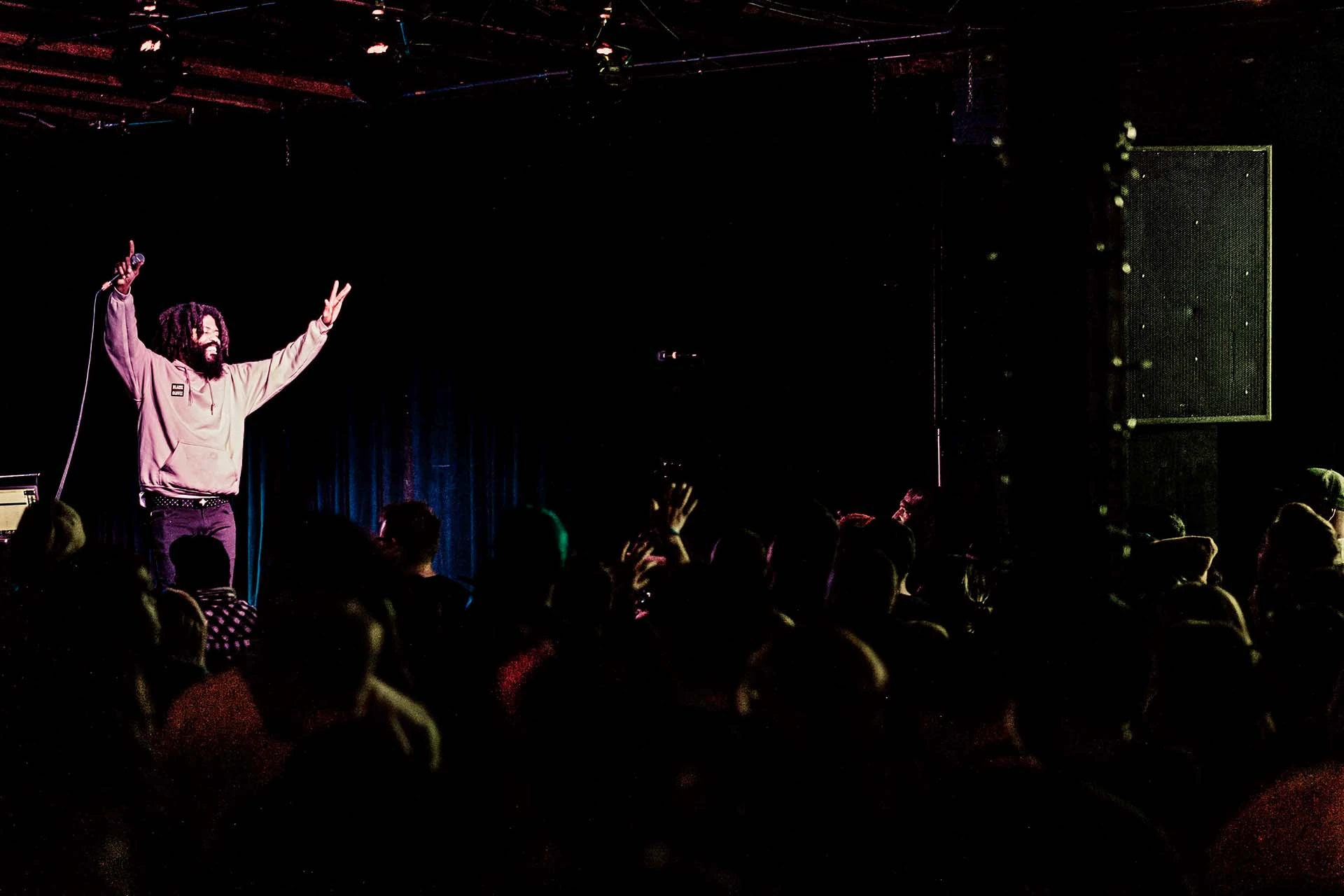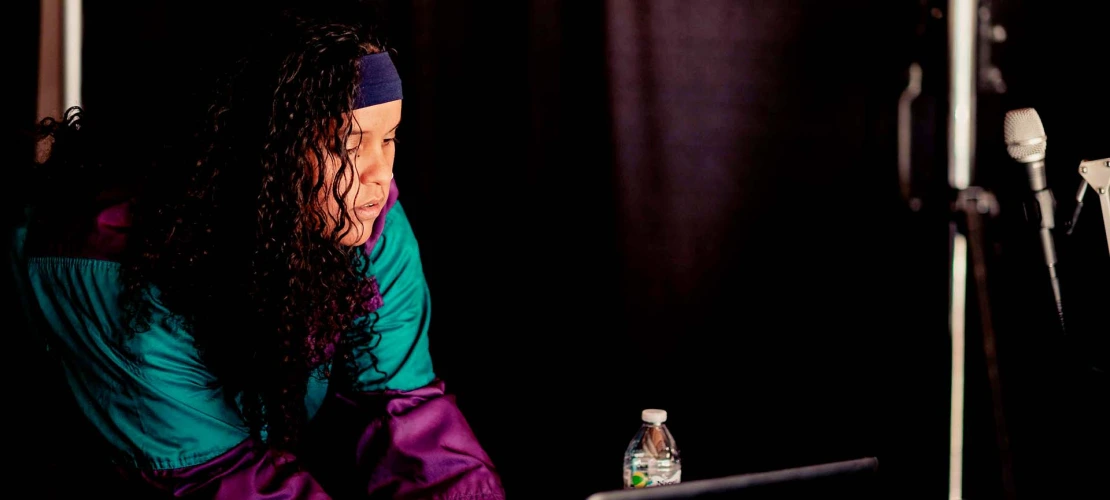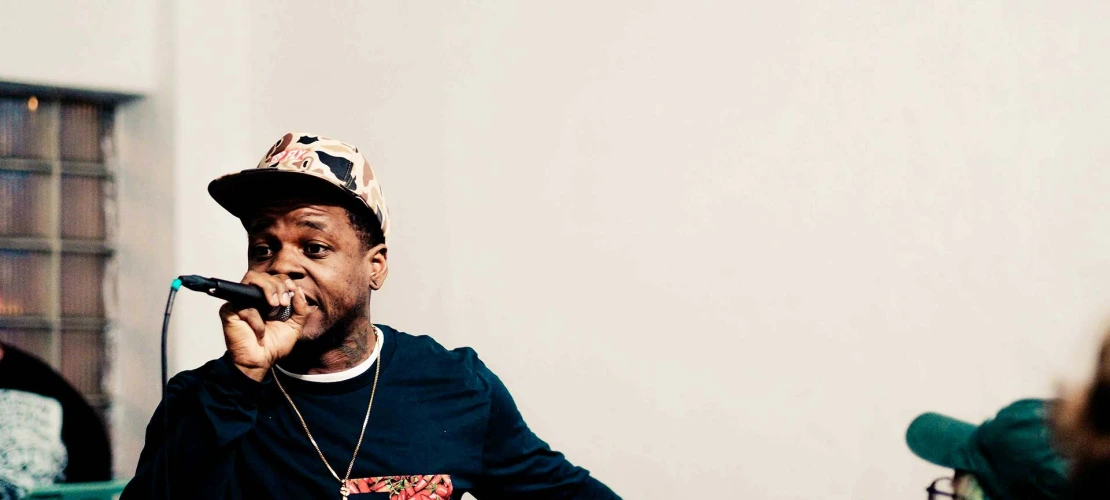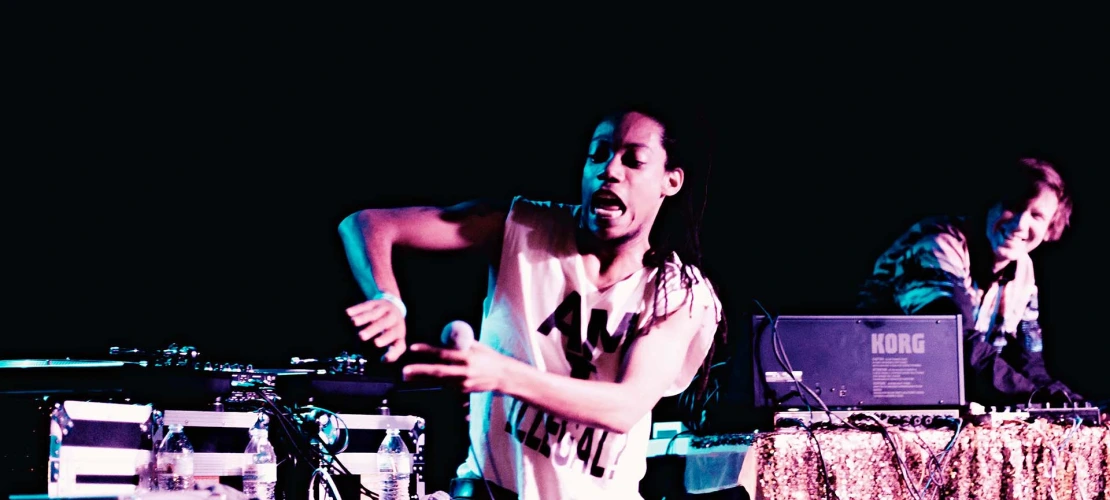A Rose from Concrete
The University of Arizona’s minor in hip-hop studies was the first in the nation. This year, as the music turns 50, the program is still listening closely.

Murs performs at the 2017 Tucson Hip Hop Festival, co-founded by Jocelyn Valencia ’15, the first University of Arizona student to graduate with a minor in hip hop cultures.
Julius Schlosburg
“You try to plant something in the concrete — you know what I mean?” begins the late Tupac Shakur on his spoken-word masterpiece “The Rose That Grew from Concrete,” his voice strong and sure over the plaintive notes of a plucked guitar and backup vocals straight out of a Sunday gospel choir.
“If it grow,” the rapper continues, “and the rose petal got all kind of scratches and marks, you’re not going to say, ’Damn, look at all the scratches and marks on the rose that grew from the concrete.’ You’re going to be like, ’Damn, a rose grew from the concrete?’”
Birds twitter and chirp in the background, almost inaudible, then louder.
“Same thing with me. You know what I mean?” intones Shakur, a funky baseline kicking in. “I grew out of all this.”
The musician contended with homelessness and his mother’s drug addiction as a teenager in Baltimore and Marin City, California, and his work grabbed hold of Alex Nava ’93 from an early age. Today, the University of Arizona religious studies professor still admires Shakur’s artistry — and he shares his interest in hip-hop with his students.
Since 2002, Nava has taught the course Rap, Culture and God, examining the intersections between hip-hop and faith. The class regularly draws more than 300 Wildcats, some of whom are “hip-hop heads” and some of whom don’t know the music at all.
For Jocelyn Valencia ’15, the first graduate of the university’s minor in hip-hop cultures, the course “opened a whole new path.”
A decade after Nava began off ring his class, the university became the first in the country with a hip-hop studies minor, a lone rose in a scholarly field now blooming. The program, housed within the department of Africana studies, turns 11 this fall, just after hip-hop as a genre celebrates its 50th birthday.
The music traces its origins to 1973 in the Bronx, where predominantly Black and brown residents relied on the sound to protest redlining, or residential segregation. At the time, says Africana studies department head Praise Zenenga, hip-hop became an expression of the identity of African Americans, Puerto Ricans and others on the margins of society.
Two thousand miles west and a generation later, Zenenga and Nava stand alongside Alain-Philippe Durand, John Melillo and Tani Sanchez ’77 ’97 ’06 as the minor’s founding faculty members.
The program serves students like Valencia, who co-founded the Tucson Hip Hop Festival and now lives in Los Angeles, where she runs a creative agency. Ben Abrams ’20, another alum, manages Degen Sports Collective, a digital and physical arts space whose Nashville gallery opening in April was attended by all-pro NFL tight end George Kittle.
Durand, described by his colleagues as the engine behind the program’s establishment, says that the minor takes cues from hip-hop based education, an approach to schooling developed by Temple University professor Marc Lamont Hill when he was a high school English teacher working in a difficult neighborhood of Philadelphia. Hill, Durand says, proposed using hip-hop to talk about everything: In the humanities, students could discuss what the practice of rap-battling reveals about the art of argumentation. Sociology courses could consider the music’s origins in reaction to the wealth of Manhattan. Computer engineers could study the samplers used by DJs to freestyle on a turntable.
The UArizona program teaches hip-hop as a discipline featuring four archetypal figures: the rapper, the break-dancer, the DJ and the graffiti artist. The music, Valencia says, could not exist without all of them. And if the music did not exist, marginalized groups around the world would have one less source of hope to turn to — because hip-hop, today, is a global phenomenon.
“There’s rappers in Russia using hip-hop as a voice of dissent against Putin,” says Nava, who also cites MC Millaray, a 16-year-old who advocates through her music for the rights of Chile’s Mapuche people.
Born and raised in Tucson, Nava grew up following his break-dancing brother to competitions against neighboring crews. He recalls listening to Grandmaster Flash’s socially conscious rap “The Message” alongside the spiritually rich music of Shakur — whose likeness can be found on murals throughout the world, notes Zenenga.
ʻThe first time I was captivated by the art of language, by words, came through hip-hop.'
Nava is a first-generation college graduate and says that hip-hop performed for him the role books have for others. “The first time I was captivated by the art of language, by words, came through hip-hop, came through the emcees I was listening to — just their rhyme schemes and their ability to work magic with words,” he says.
Sanchez, a professor of practice in Africana studies who specializes in media and film, teaches courses within the minor focusing on hip-hop cinema and Blacks in Hollywood. Politically inflected hip-hop, she says, “is a way for people to become aware of another way of being.” That swung-open door is valuable in a school setting.
“My impression is many students have questions,” Sanchez says. “They’re like, ’OK, I’m here at this university. How can I learn about my world?’ And this is one way to learn more about it, to learn about race relations, power relations, to learn how people create, how they have joy, to learn how people challenge and also resist.”
Among the films Sanchez uses in classes is “Straight Outta Compton,” which follows the true-to-life tale of the strivers who overcame gang violence and poverty to form N.W.A., a hit rap group, in the late ’80s. In one scene, a teenaged Andre Young lies on the floor of his bedroom surrounded by vinyl records, eyes shut, moving his hands like a conductor to the soul music sounding through his headphones.
Later on, after Young — better known as Dr. Dre — and his bandmates have made it big, they perform to a maximum-capacity crowd in Detroit. Law enforcement orders them not to play a song protesting police brutality, but they do so anyway, boldly and to the audience’s delight.
During spring break in 2023, Zenenga and Nava led a “study away” to New York City, where the professors — both of whom completed graduate school in the rap hotbed of Chicago — accompanied students on the “hip-hop route” through the city’s boroughs. Each day, a guide greeted the group by calling out, in a salute to the date recognized as the music’s birth, “August 11!” The tour-goers responded in kind, “1973!”
On that pivotal summer day in the Bronx, an 18-year-old DJ, Kool Herc, began toying with his turntables, extending instrumental interludes for dancing guests at his sister’s back-to-school party so that they could freestyle. A friend, Coke La Rock, rapped over the isolated “breaks” — and a genre that Zenenga says is “mostly about improvisation” broke through the cracks. Others in the city were also exploring the sound.
Zenenga, who received his interdisciplinary doctorate in theater and drama, echoes Nava’s ideas about the power of language in hip-hop, saying, “It is verse; it is rhyme; it is poetry; it is spoken word.” He speaks of Halifu Osumare, an emeritus professor at the University of California, Davis, who has argued that hip-hop traces back to the griot, the praise singer and poet in West African societies. “People tell stories about their lives,” he says. “They tell stories about their personalities, their communities, their identities.”
Within the program, Zenenga offers a course on hip-hop dance, while Durand, Dorrance dean of the College of Humanities, teaches U.S. and French hip-hop cultures, a subject he first brought to the classroom in 2003 at the University of Rhode Island. Other active faculty in the minor include Associate Professor Erika Gault, lecturer Johnny Castro and Assistant Professor Jerome Dotson. Melillo continues to teach courses on sound studies within the English department.
Nava has thought, written and taught extensively on the relationship between hip-hop and faith within disenfranchised communities. His most recent book, “Street Scriptures: Between God and Hip-Hop,” looks closely at the work of Kendrick Lamar, whose religious concerns, in arising from experiences of oppression and feelings of despair, align with those of Shakur, Lauryn Hill and the Wu-Tang Clan, he says. He calls Lamar a gift to his course.
“I think Kendrick Lamar has a very rich and profound view of religion and spirituality,” Nava says. “It’s not at all simplistic. It’s not at all dogmatic. It’s not at all preachy. It’s a sincere search for God, and I think it’s an important part of who he is as a rapper.”
Alumna Valencia co-founded the Tucson Hip Hop Festival with Pike Romero, a local DJ, in 2015. The festival, held most recently in 2022, has showcased artists in each of hip-hop’s four elements while incorporating conference-style presentations. Valencia says that she is most proud of the festival for “gifting hundreds of artists the opportunity to share what they’re passionate about.” Many of the performers accepted to date, she says, had never displayed their talents on a festival stage.
Durand is thankful to see alums like Valencia making their way outside the university. He says that their successes show the value of the minor — and of the humanities in general. Mostly, he is glad when former students like Valencia, Abrams and Eli Piccarreta ’16, who today represents the hip-hop star YoungBoy Never Broke Again, reach out to see how they can help or just to say hello.
“That means that they had a good experience,” he says. “That means that they feel like what they have learned here is serving them well.”




